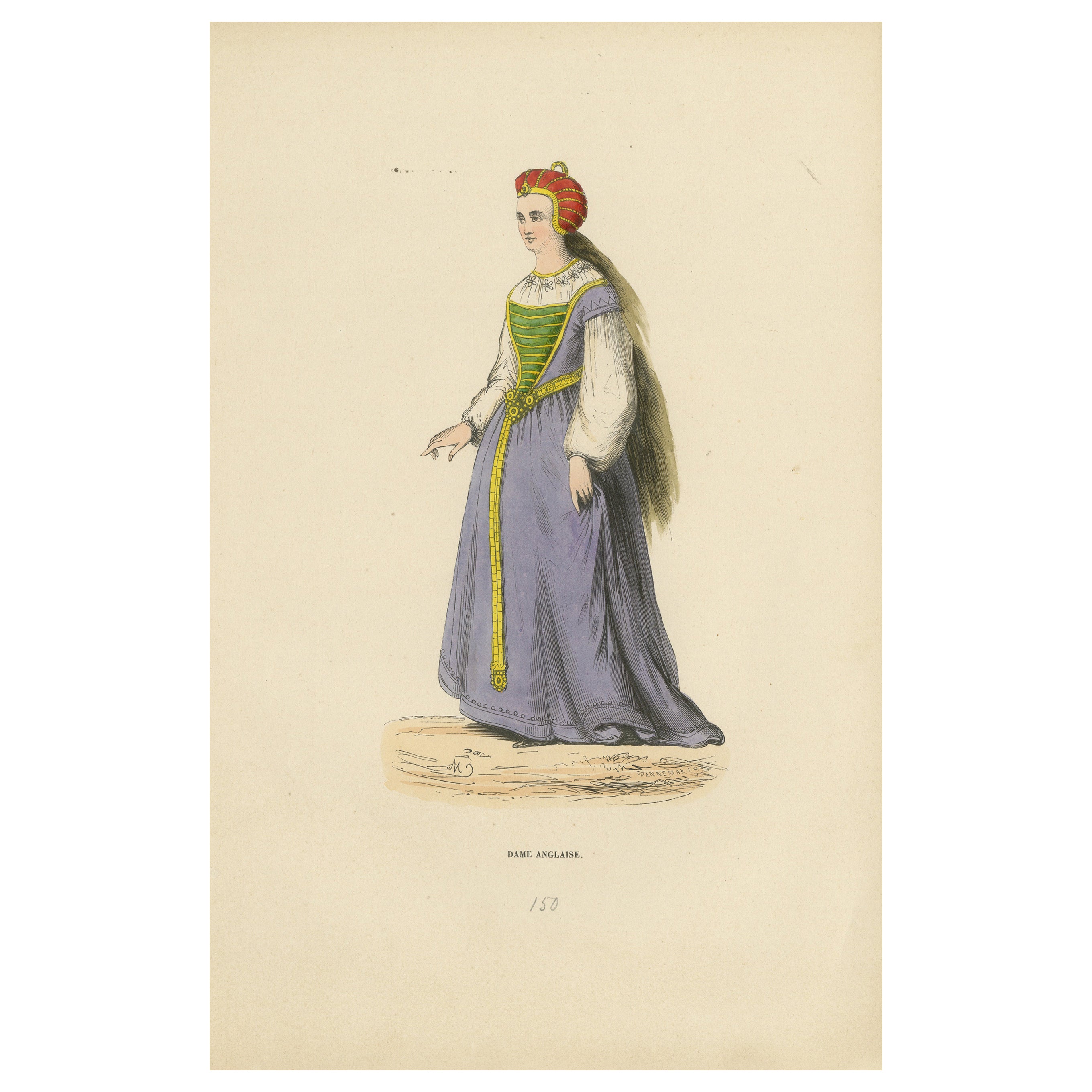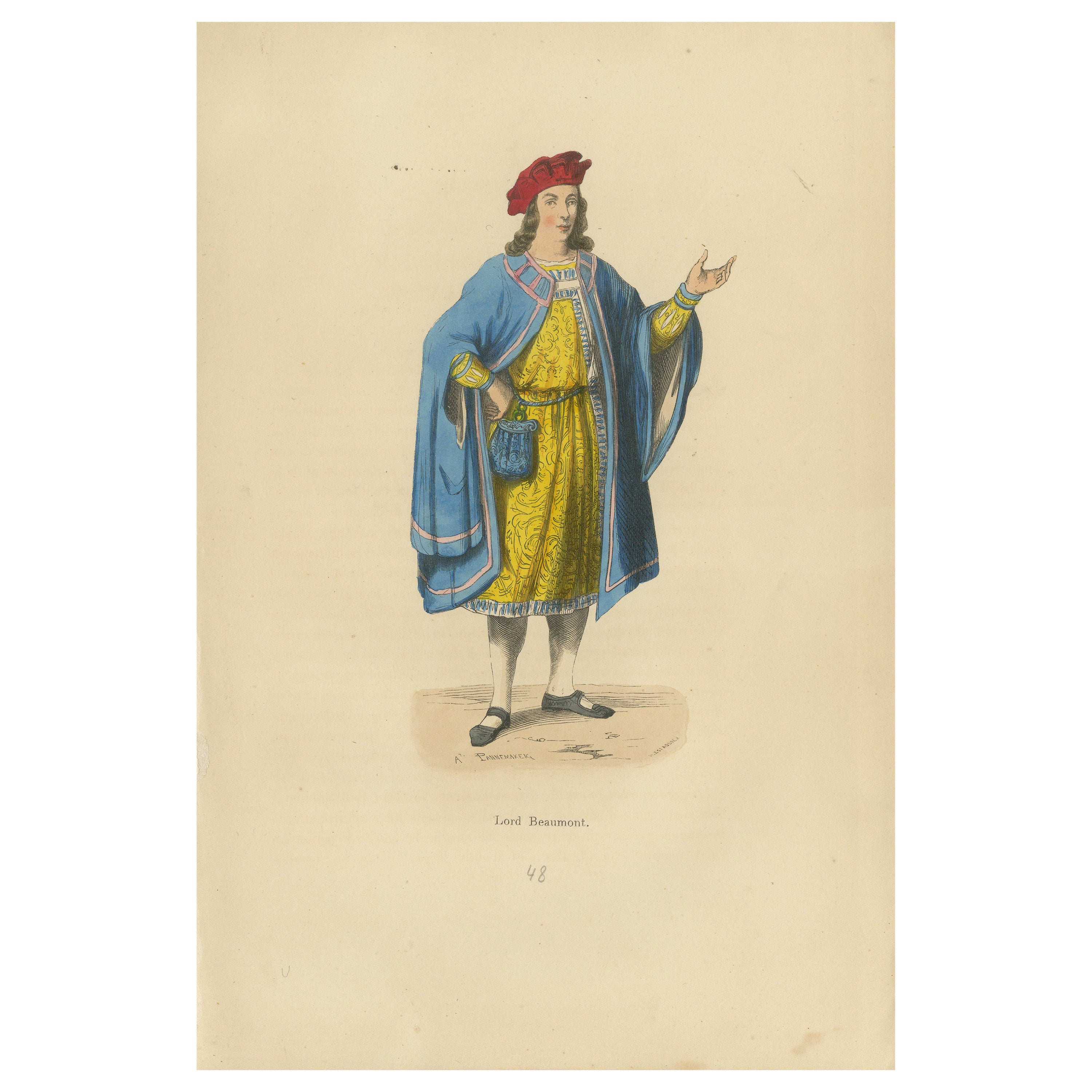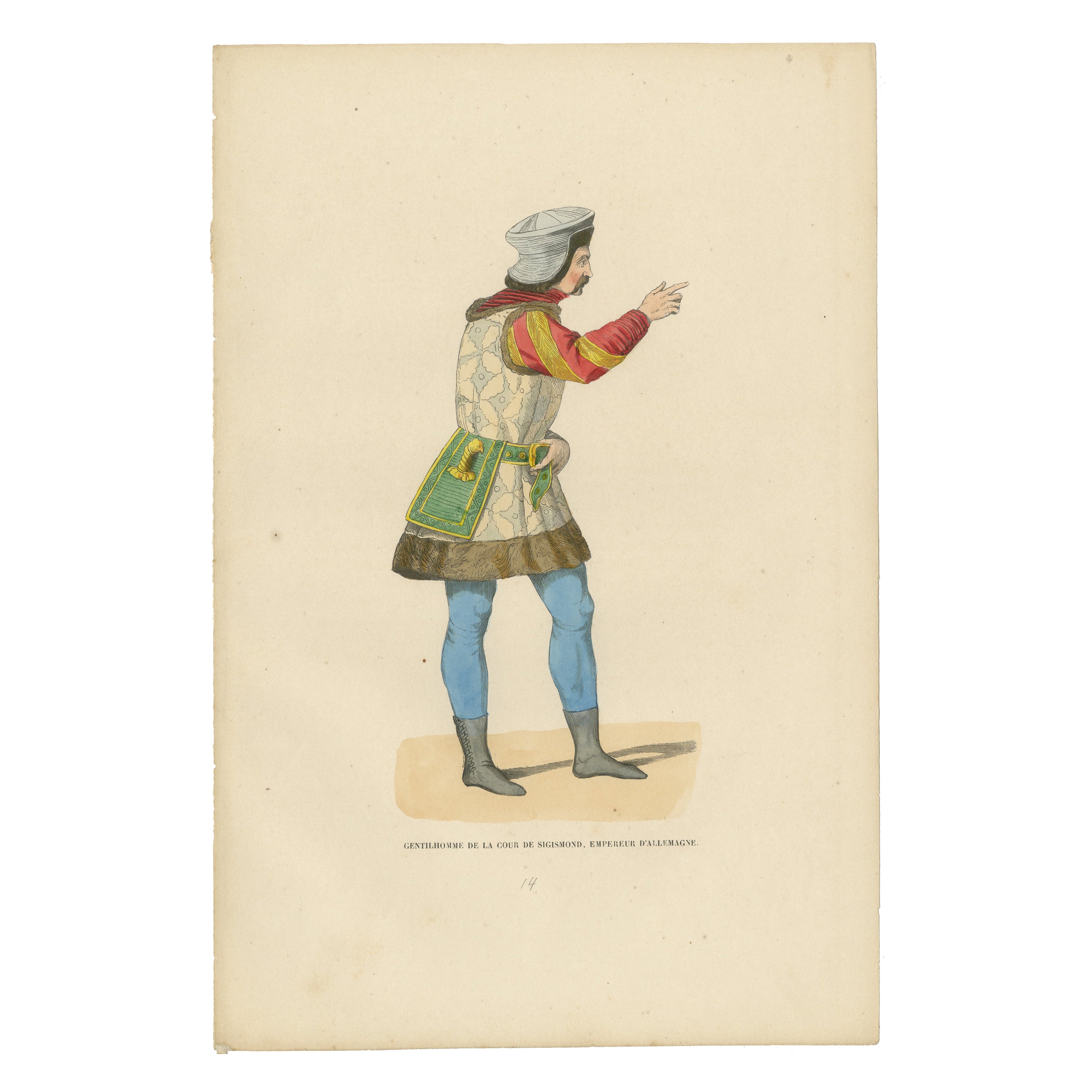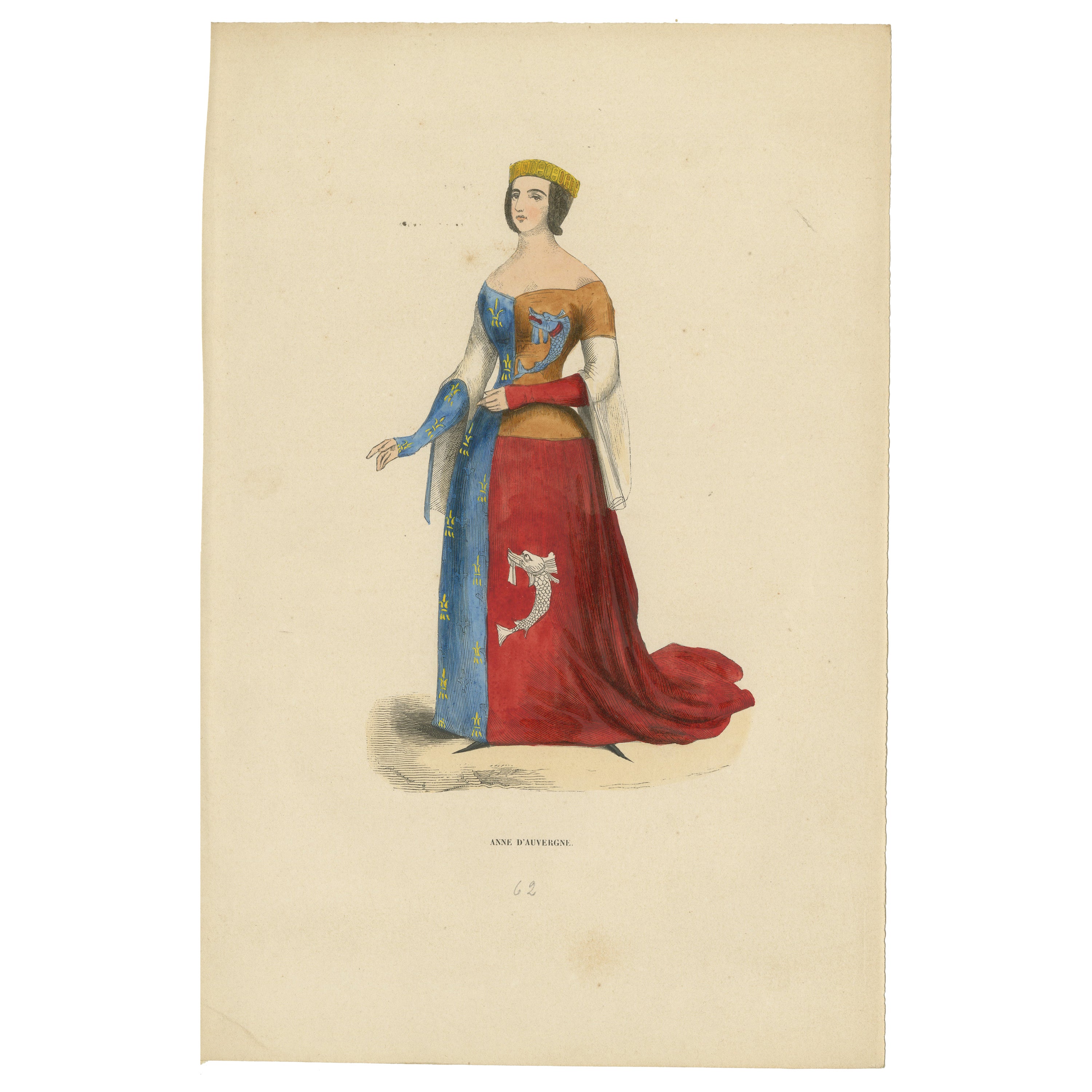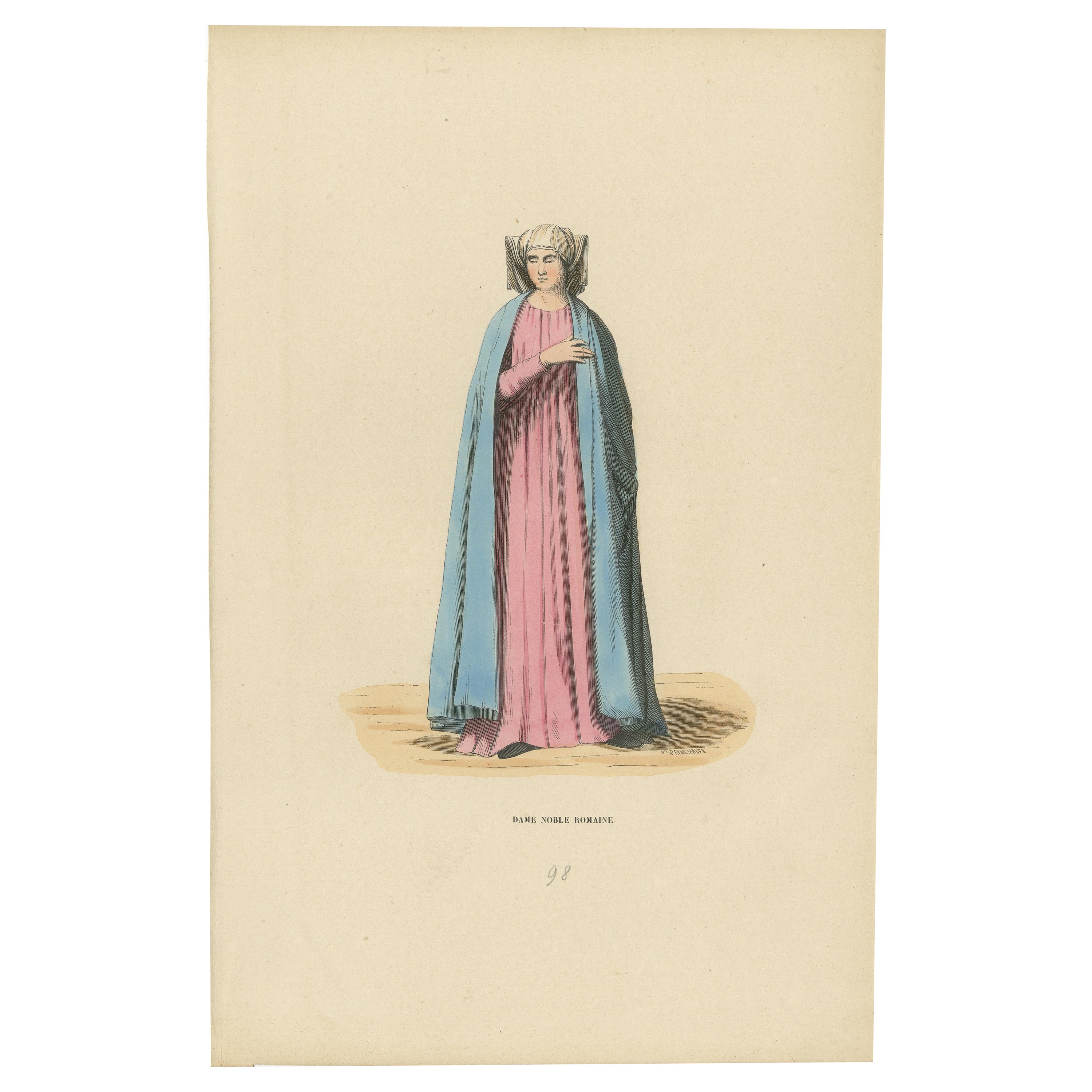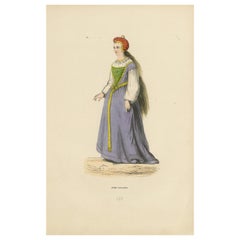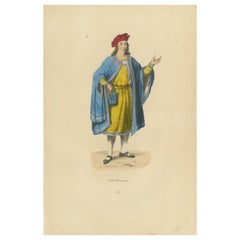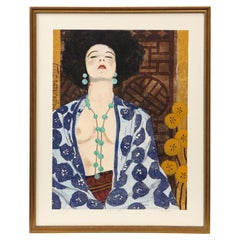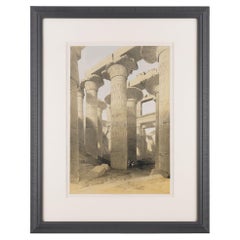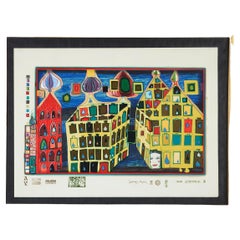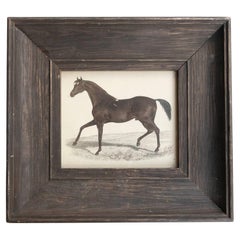Items Similar to Courtly Refinement: A Lady-in-Waiting to the Dauphine of Auvergne, 1847
Want more images or videos?
Request additional images or videos from the seller
1 of 6
Courtly Refinement: A Lady-in-Waiting to the Dauphine of Auvergne, 1847
About the Item
Title: "Courtly Refinement: A Lady-in-Waiting to the Dauphine of Auvergne in 'Costume du Moyen Âge'"
Description: This delicate lithograph from the "Costume du Moyen Âge" series, published in 1847, presents a lady-in-waiting to the Dauphine of Auvergne, showcasing the elegance and sophistication of her courtly attire. The lady is portrayed in a side profile, her expression serene, embodying the grace and poise expected of someone in her esteemed position at court.
She is clothed in a dress that is a visual testament to her role within the noble hierarchy, with a fitted bodice and a flowing skirt. The dress features a striking color combination of blue and white, segmented in a manner that reflects the fashion of the era, with a red panel that provides a bold contrast. The bodice is adorned with green bird motifs, which may represent a specific heraldic symbol or perhaps a personal or regional affiliation.
Her sleeves are tight and red, a common style of the period, which contrasts with the more expansive white under-sleeves. The lady's attire is further accentuated by a flowing translucent veil that hangs from her headdress, a typical headwear style known as a hennin, which was popular among the noblewomen of the time.
The lady's posture, with one hand delicately adjusting the fabric of her skirt, suggests movement and a gentle demeanor. Her other hand is obscured in the folds of her gown, adding a demure and refined quality to her pose.
This lithograph not only captures the fashion of the time but also serves to illustrate the daily life and sartorial splendor of a lady-in-waiting to the Dauphine of Auvergne. It provides a window into the world of French nobility, highlighting the intricate details and patterns that were fashionable among the courtiers of the Middle Ages.
The colors have a nice glow over them. Historically, egg whites, known as glair, and sometimes egg yolk were indeed used in illumination and painting, particularly in manuscripts, to give colors a brighter appearance and to add a sheen or gloss to the work. This technique was quite common during the Middle Ages and into the Renaissance.
Egg whites can be applied as a varnish over pigments to enhance their brightness and to protect the colors. This application could make the colors appear more vivid and also add a slight glossy sheen to the surface of the image.
Egg yolk, on the other hand, was commonly used as a binding agent in paint. It forms the basis of tempera paint, a medium that was widely used before the advent of oil painting. Egg yolk helps to create a durable and long-lasting color that adheres well to various surfaces.
In the context of the print from 1847, it's less likely that egg whites or yolks were used directly on the print, as by that time, commercial printing processes would have been more advanced and less reliant on such manual methods. However, if this print is a representation of an earlier style or is meant to mimic the appearance of hand-painted manuscripts, the original artists might have employed techniques or materials that gave a similar effect to those achieved with egg-based binders and varnishes.
- Dimensions:Height: 10.63 in (27 cm)Width: 7.09 in (18 cm)Depth: 0 in (0.02 mm)
- Materials and Techniques:
- Period:
- Date of Manufacture:1847
- Condition:Good. Overal light toning and light soiling but the image itself clean and hand-colored almost 200 years ago and still in expliciet colors. Aged paper with typically warm, yellowish-brown hue, mostly around the edges. Study the images carefully.
- Seller Location:Langweer, NL
- Reference Number:Seller: BG-13635-1231stDibs: LU3054337927722
About the Seller
5.0
Platinum Seller
These expertly vetted sellers are 1stDibs' most experienced sellers and are rated highest by our customers.
Established in 2009
1stDibs seller since 2017
2,012 sales on 1stDibs
Typical response time: <1 hour
- ShippingRetrieving quote...Ships From: Langweer, Netherlands
- Return PolicyA return for this item may be initiated within 14 days of delivery.
Authenticity Guarantee
In the unlikely event there’s an issue with an item’s authenticity, contact us within 1 year for a full refund. DetailsMoney-Back Guarantee
If your item is not as described, is damaged in transit, or does not arrive, contact us within 7 days for a full refund. Details24-Hour Cancellation
You have a 24-hour grace period in which to reconsider your purchase, with no questions asked.Vetted Professional Sellers
Our world-class sellers must adhere to strict standards for service and quality, maintaining the integrity of our listings.Price-Match Guarantee
If you find that a seller listed the same item for a lower price elsewhere, we’ll match it.Trusted Global Delivery
Our best-in-class carrier network provides specialized shipping options worldwide, including custom delivery.More From This Seller
View AllRenaissance Refinement: An English Lady in 'Costume du Moyen Âge, 1847
Located in Langweer, NL
Title: "Renaissance Refinement: An English Lady in 'Costume du Moyen Âge'"
Description: This lithograph, part of the "Costume du Moyen Âge" series from 1847, depicts an English nobl...
Category
Antique 1840s Prints
Materials
Paper
Lord Beaumont in Courtly Attire, Costume Di Moyen Age, 1847
Located in Langweer, NL
The image shows a figure labeled as "Lord Beaumont," depicted in medieval attire. He is wearing a blue overcoat with a fur trim and a gold-patterned undergarment that extends to his ...
Category
Antique 1840s Prints
Materials
Paper
Courtly Splendor: A Nobleman at Emperor Sigismund's Court, 1847
Located in Langweer, NL
The image depicts a man identified as a "Gentilhomme de la cour de Sigismond, empereur d'Allemagne," which translates to "Gentleman of the court of Sigismund, Emperor of Germany."
This individual is portrayed in a profile stance, dressed in attire that is indicative of the high-status courtiers during the time of Emperor Sigismund, who reigned in the early 15th century. He is wearing a turban-like headgear, which reflects the influence of Eastern fashion on European court attire, possibly due to the Ottoman influence or the general exchange of culture during the Crusades and subsequent interactions.
His doublet is richly patterned and he has puffed sleeves in red, which were fashionable among the nobility during the period. The garment is accented with a decorative belt that holds what appears to be a purse or a pouch. He also sports tight blue hose and pointed shoes, which complete the ensemble typical of a nobleman or a high-ranking court official in the Holy Roman Empire.
Egg whites can be applied as a varnish over pigments to enhance their brightness and to protect the colors. This application could make the colors appear more vivid and also add a slight glossy sheen to the surface of the image.
Egg yolk, on the other hand, was commonly used as a binding agent in paint. It forms the basis of tempera paint, a medium that was widely used before the advent of oil painting. Egg yolk helps to create a durable and long-lasting color that adheres well to various surfaces.
In the context of the print from 1847, it's less likely that egg whites or yolks were used directly on the print, as by that time, commercial printing processes would have been more advanced and less reliant on such manual methods. However, if this print is a representation of an earlier style or is meant to mimic the appearance of hand-painted manuscripts...
Category
Antique 1840s Prints
Materials
Paper
Anne d'Auvergne: Nobility in Heraldic Robes, Hand-colored in 1847
Located in Langweer, NL
Title: "Anne d'Auvergne: Nobility in Heraldic Robes"
Description: This print represents Anne d'Auvergne, a figure of nobility, depicted in a stately and refined manner. She is clad ...
Category
Antique 1840s Prints
Materials
Paper
Noble Falconer: Lady of the 15th Century, 1847
Located in Langweer, NL
Title: "Noble Falconer: Lady of the 15th Century"
Description: This print captures the noble pastime of falconry, a sport historically associated with the aristocracy, through the p...
Category
Antique 1840s Prints
Materials
Paper
Noble Roman Lady of the Middle Ages, Handcolored and Published in 1847
Located in Langweer, NL
Title: "Noble Roman Lady of the Middle Ages"
Description: The print shows a portrayal of a "Dame Noble Romaine," which translates to "Noble Roman Lady," from the Middle Ages. It is ...
Category
Antique 1840s Prints
Materials
Paper
You May Also Like
Lady in Waiting Print by Walter Buttrick
Located in New York, NY
A wonderful print by the Bostonian artist that is a homage to Gustav Klimt and Japanese woodblock printing. The figure sits in the foreground partia...
Category
1990s North American Art Nouveau Prints
Materials
Paper
Hall of Columns in the Temple of Karnak by David Roberts, 1847
By David Roberts
Located in Kenilworth, IL
This work, titled “Karnac" is an oblique view of the Hall of Columns in the Temple of Karnak in Egypt, from Robert's two volume set of lithographs, “Views of the Holy Land.” The work...
Category
Antique 1840s British Prints
Materials
Paper
Friedensreich Hundertwasser “It hurts to wait with love in somewhere else”
By Hundertwasser
Located in Vienna, AT
Friedensreich Hundertwasser, color screen print with metal embossing “It hurts to wait with love in somewhere else”. published by Ars Viva, Zurich 1971-72, stamp signed and numbered ...
Category
Vintage 1970s Austrian Modern Prints
Materials
Paper
Original Antique Print of a Racehorse, 1847
Located in St Annes, Lancashire
Great image of a racehorse presented in an antique oak frame
Lithograph after George Stubbs with original hand color.
Published, 1847.
Category
Antique 1840s English Folk Art Prints
Materials
Oak, Paper
Original Antique Print of a Hummingbird, 1847
Located in St Annes, Lancashire
Great image of a hummingbird presented in a slightly distressed antique gilt frame.
Lithograph after Cpt. brown with original hand color.
Published, 1847.
Free shipping.
Category
Antique 1840s English Folk Art Prints
Materials
Gesso, Paper
Earl Bliss "Rising to the Call of the Fog in the Morning" Serigraph 2/10 Signed
Located in Atlanta, GA
Earl Biss (American, 1947-1998), "Rising to The Call of the Fog in the Morning", lithograph on paper, signed to the lower margin 'Biss, 80" and with Peter C. Holmes of Origins Press ...
Category
Late 20th Century American Native American Prints
Materials
Paper
$2,316 Sale Price
20% Off
Recently Viewed
View AllMore Ways To Browse
Antique Bodice
Lady In Gown
French Renaissance Fabric
Used Adjustable Dress Form
Noble Lady
Court Lady
Dauphine Furniture
Bird Headdress
Heraldic Window
Austrian Antique Rings
Black Lacquer China Cabinet
French High Buffet
Japanese Art Of Cranes
Japanese Wooden Chair
Long French Buffet
Modernist Display Case
Oak School Cabinet
Old Glass Beads
